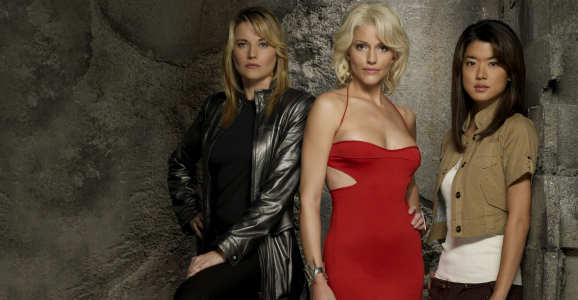Ron Moore Reveals Why The Battlestar Galactica Reboot Gave Us Humanoid Cylons
This article is more than 2 years old
 Yet another San Diego Comic-Con packed in crowds last week, giving genre fans the opportunity to meet their idols and see exclusive new footage from upcoming films and television. It also allows fans to come together and celebrate beloved but older properties. Science fiction TV writer and producer Ronald D. Moore was making the rounds to promote his new Syfy series Helix, but he also reminisced about the mysteries of his critically acclaimed Battlestar Galactica reboot. While questions about the final moments of Kara “Starbuck” Thrace remained unanswered, Moore did shed some light on why the new BSG gave the Cylons a humanoid makeover.
Yet another San Diego Comic-Con packed in crowds last week, giving genre fans the opportunity to meet their idols and see exclusive new footage from upcoming films and television. It also allows fans to come together and celebrate beloved but older properties. Science fiction TV writer and producer Ronald D. Moore was making the rounds to promote his new Syfy series Helix, but he also reminisced about the mysteries of his critically acclaimed Battlestar Galactica reboot. While questions about the final moments of Kara “Starbuck” Thrace remained unanswered, Moore did shed some light on why the new BSG gave the Cylons a humanoid makeover.
While the original Battlestar Galactica also featured Cylons, they were the iconic, shiny-chrome robots we all know and love, whereas as the reboot made many large and small changes to the Cylons and their relationship with their creators. Affectionately called “Skinjobs,” some of the new-and-proved Cylons took human form, and the implication that anybody could be an undercover Cylon served as the basis for many plot points as the seasons rolled on. Moore explained why his reboot went in this direction, and it wasn’t just because he was trying to make a philosophical statement about mankind and existence. It certainly took the story in interesting directions, but the initial decision came down simply to budget: namely, not having enough of it. Moore told the Comic-Con crowd:
The fact that the Cylons look like people was driven by budgetary constraints. They were originally guys in chrome suits. [When we were brainstorming] we asked, what will audiences want to see now? How many of those suits can we build practically? Pretty much two or three. So that’s not satisfying, but what about CGI? How much CGI can I do of Cylons every week? Not much. We had a bull session and somebody said why not go the Blade Runner route and make them look like human beings? My first response was like, ‘That’s lame.’ I came around. I wondered, if they look like people and used to look like robots, what does that imply? The robots decided to evolve themselves to look like humans. Why would a robot decide that? Maybe they are evolving to what they see as their parents. Now we’re in interesting territory. Yeah, I said, let’s go that direction. And it all came from a budgetary problem.
Budget restraints are a concern that faces any writer trying to tell ambitious science fiction stories on the small screen, but the strengths of the Battlestar reboot demonstrate the best-case scenario of what can happen when creative people take lemons and make lemonade.
In fact, the decision may have helped more mainstream audiences buy into the BSG reboot, in a way they might not have if all the action came down to humans and toasters. Tricia Helfer, Grace Park, and Lucy Lawless gave the Cylons a humanity and depth we probably wouldn’t have gotten out of featureless chrome robot suits. Also, Number Six seducing Dr. Gaius Baltar would’ve been a lot more unsettling.
As for Ron Moore, Helix will be airing on Syfy in early 2014. Helix recently cast Billy Campbell in the series’ lead role of Dr. Alan Farragut, “an emotionally troubled Centers for Disease Control pathologist whose marriage has recently fallen apart after his wife had an affair with his brother.” Helix centers on a group of scientists stationed in the middle of the Arctic. The CDC scientists were sent there to investigate a possible outbreak, but little do they know that something much more terrifying is lurking beneath the icy surface.
It’s very cool to see a TV series like Battlestar Galactica still has the power to generate fan enthusiasm and controversy years later. If you haven’t watched BSG before, what are you waiting for? It’s available for online streaming on Netflix and Hulu.












